Davidson plum is a splendid and special Australian native plant. This small to medium rainforest tree boasts attractive features all-round and is an excellent choice for any gardener looking for a low-maintenance garden ornamental.
Adored for its decorative edible fruits and luscious green, frond-like foliage, this tree has rightfully garnered a long-lived status as a popular bush tucker plant. Here is everything you need to know to grow and care for your Davidson's plum tree.
More...
Family: | Cunoniaceae |
|---|---|
Genus: | Davidsonia |
Species: | Davidsonia pruriens Davidsonia jerseyana Davidsonia johnsonii |
Common Names: | Davidson’s Plum, Davidson Plum |
Location: | Outdoor |
Type: | Tree |
Growth: | 5 to 10 metres tall, 2 to 4 metres wide |
Sun requirements: | Partial sun to full sun |
Foliage Colour: | Green |
Flower Colour: | Purple-pink |
Flowering: | Spring |
Fruit: | Blue to Burgundy skin with red flesh |
Maintenance level: | Low to medium |
Poisonous for pets: | Toxic to cats and dogs |
With the ability to add tropical tones and textures to any landscape, this gorgeous native evergreen has become a popular choice as a feature plant in Australian gardens.
The wild and luscious greenery offered by this tree is harmoniously accompanied by its vibrant fruits and attractive growth habit. Knowing how to maintain and care for this perennial will ensure you can establish a healthy and thriving Davidson plum tree so you can reap the fruits of your labour for years to come.
Davidson Plum Plant Details
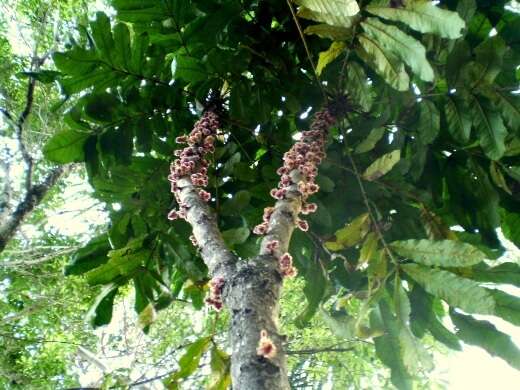
Source: en.wikipedia.org
Davidsonia is a genus a part of the Cunoniaceae family containing three tree species native to Australia, namely Davidsonia pruriens, Davidsonia jerseyana and Davidsonia johnsonii.
These trees are native to the subtropical and tropical rainforests of eastern Australia where they thrive in warmer climate zones with high humidity but they can also be successfully established in cooler areas as long as they are protected from frost.
Commonly referred to as Davidson’s Plum or “orray”, these tree species are all popular due to their plum-sized, edible dark-purple to blue fruits that have been considered gourmet bush food by locals for generations.
These slender-trunked rainforest trees grow to be around 5 to 10 metres tall and 2 to 4 metres wide with a medium growth rate. When ripe, the fruits turn from green to dark blue with red flesh throughout that resembles the common European plum.
The fruits have an intense tangy-sour flavour that makes them a little too unpalatable to eat fresh, however, these fruits make for superb fruit-based additions to jams, sauces, yoghurts, wines and savoury recipes.
A Davidson plum tree can take 3 to 6 years to start bearing fruit depending on the species but, even before that, you can easily enjoy this beautiful tropical addition to your garden.
Davidson’s Plum Species
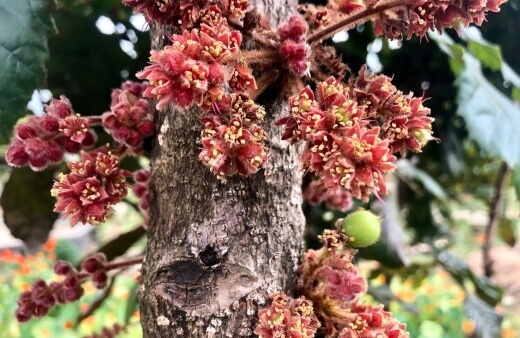
- Davidsonia jerseyana – Native to the lowland subtropical rainforests of northern New South Wales, this species of Davidson’s plum is widely cultivated for its particularly good and tasty fruit that is commonly used in many preserves and condiments.
- Davidsonia pruriens – This is the best-known species of Davidson plum that is native to the rainforests of northern New South Wales and north Queensland.
This is a taller growing variety than the other two species that can reach up to 12 metres high in the right conditions. It also produces larger fruits. - Davidsonia johnsonii – This is a smaller growing species of Davidson’s plum with a spreading canopy and smooth leaves. Native to New South Wales and south east Queensland, this species is not widely cultivated because of its infertile seeds.
A unique decorative quality these trees feature is how the fruits grow in large spiralling clusters straight from the trunks and branches. The complementary display of clustered new green fruits and ripened dark-burgundy to blue fruits highlighted by a canopy of attractive, vibrant foliage makes this tree an excellent lively garden ornamental.
It produces red and furry new growth as well as soft and textured reddish-pink flowers. These trees can suit tougher spots in your landscape as they feature column-shaped growth habits that are ideal for narrower spaces.
Growing Davidson Plum tree
These trees are best grown from seeds, bought from local nurseries or specialist online stores, during early spring. While being established, the Davidson plum tree can be used as a decorative container plant to start where it can be placed around your natural spaces outside or used indoors for a few weeks at a time.
It will however eventually have to be transplanted into its forever home in the garden to grow to its full potential and produce abundant fruits. For this reason, many growers choose to establish the tree straight in their gardens.
How to Grow Davidson Plum from Seeds
- Gently remove the flesh from the seeds and soak them in warm water overnight.
- Sow your seeds into a tray filled with organic seed-raising or potting mix.
- Softly push the seeds into the soil until they are fully submerged.
- Mist or water the seeds lightly after planting them in the soil.
- Place the seeds in a warm, brightly lit position out of direct sunlight.
- Mist regularly to keep the soil mix moist.
- Germination can take anywhere from 3 weeks to several months depending on the conditions and species so be patient and you should have successfully sprouted seedlings in no time.
Planting Davidson Plum Tree
Once you have a healthy and developing seedling, you can plant it in your desired location in a sheltered spot in the garden or plant it in a container for the first few years of establishment.
Either way, this tree will require certain growing conditions and environments to thrive and look as good as possible. Being native to rainforests, these trees grow best in sheltered, partly shaded positions in the garden with ample moisture and protection from damaging winds and frost.
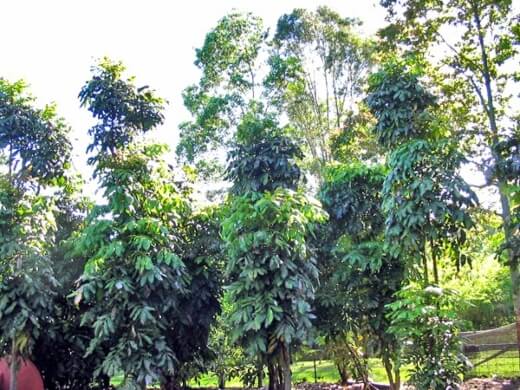
Source: wendynswdavidsonplum.blogspot.com/
Davidson's Plum Sun Requirements
Partial sun is preferred but this tree will also grow in full sun positions. A couple of hours of direct sun each day is okay but filtered and dappled light throughout the day is ideal.
Best Soil for Davidsonia
In their native habitats, these trees grow in a range of soil types. They can withstand acidic soils or more neutral soil types. Clay soils or loamy and sandy soils should all work great.
They tend to grow best in well-draining, deep, friable soils with plenty of organic material. For container growing, an organic potting mix is recommended.
Temperature & Humidity
Being a tropical plant, this tree thrives in warm environments with plenty of moisture and humidity. However, these hardy natives can also grow in cooler climates as long as they are protected from long exposure to frost and they can grow well in almost any area of the country.
How to Plant the Davidson Plum Tree
It is recommended to plant this tree in late autumn to spring, leaving a good chunk of warm weather while the plant establishes itself. To plant your Davidson’s plum tree, follow these simple steps:
- Dig a hole at least twice the size of the root ball of the tree.
(Get a reliable digging tool by reading our spade and shovel 2023 buying guide) - Loosen the soil at the bottom of your planting hole and optionally add some organic compost to mix into the soil.
- Gently place your tree into the hole and backfill with soil, keeping the stem of the tree at the same height in the ground as it was in your pot.
- Carefully pat the soil firm around the stem being sure not to overly compact it.
- Water well and regularly for the first few weeks to help the roots establish and stabilise themselves in the soil.
Davidson Plum Care Tips
Generally, these native trees are pretty hardy and well suited to grow in our sometimes-harsher conditions. Frost exposure for long periods can prove damaging so be sure to take the necessary precautions to avoid this.
As the tree grows, it will respond well to maintenance and care that can help ensure the foliage grows dense and vibrant, and that the tree fruits abundantly.
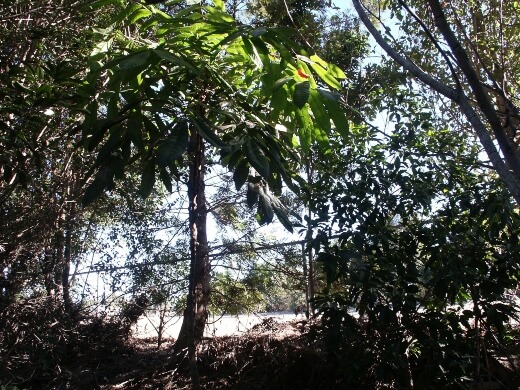
Source: ppnn.org.au
Watering Davidson's Plum
Young trees will need to be watered about once per week to encourage healthy root growth. Once established, a regular watering routine is recommended, especially in dry summer months.
Water deeply once every two to four weeks generally. These trees require good irrigation or high natural rainfall, especially during flowering and fruiting.
What Fertiliser to Use
For newly planted plum trees, fertilising in early spring with a balanced 10-10-10 fertiliser is recommended. Once established, you can fertilise your tree as needed to promote new growth and assist with fruiting during the active growing seasons.
You can find special bush tucker fertiliser for native plants at certain nurseries or online stores if you feel you want to use something more tailored to these natives.
Pruning Davidsonia
Prune off the tips and cut back your tree to control height and shape. Pruning will also encourage multiple stems and fruiting. For easier maintenance and harvesting, prune your tree to roughly your height.
This will create more lateral branch growth where you can choose the best 4 to 5, well-spaced branches for better light and air circulation.
Check out our extensive guide to pruning Australian natives to learn how to do so.
Davidson Plum Bush Tucker Guide
As mentioned earlier, it is not recommended to eat these fruits fresh but rather use them stewed or preserved to make jams or other condiments. Many love to make delicious jams from the “orray” fruits where classic European plum recipes tend to work great.
For such recipes, it is recommended to double to sugar content due to the plum’s intense acidic nature. The flesh of the plum also makes for a fantastic addition to savoury dishes or can be used as a natural food colourant thanks to the intense colour of the fruits.

Source: nqtrees.com.au
Davidson's Plum Nutrients
These fruits are rich in nutrients. They have 100 times the vitamin C content found in oranges and they have more antioxidants than blueberries which are well-known for their health benefits. Davidson’s plum fruits contain lutein which is important for eye health.
Some other beneficial nutrients include vitamin E, folate, zinc, magnesium and calcium. To get the most from the nutrient content of these fruits, you should use the skin and flesh.
Preservative Properties
Research is still being done into the fruits' preservative properties but when tested on kangaroo meat, a product made from Davidson plum was able to extend the shelf life of the meat by 21 days in chilled conditions.
Harvesting Davidson Plums
After the flowering seasons, fruits will begin to develop in clusters along the branches or trunk of the tree. Once the fruits start to turn burgundy from green, you will know they are about ready for picking.
To harvest these fruits, give the trunk of your tree a firm shake and the ripe fruits will readily fall from above. The fruits can be collected and used straight from picking in the kitchen.
These fruits make for excellent fruit-based additions to jams, sauces, yoghurts, wines, savoury recipes and much more. Be sure to look online for exact recipe ideas and other exciting uses for these native piquant plums.
Common Davidson Plum Pests & Problems
Many of the pest and disease issues these trees can face stem from the abundant fruits they produce. To help avoid any problems, be sure to always harvest ready fruits and collect fallen fruits from around the tree.
This will help deter and prevent critters and other wildlife from gathering and interfering with your tree’s health. Some of these infestations can include fruit flies, caterpillars, beetles, birds, possums and even flying foxes in some areas.
They are all attracted to the fruit so netting the tree at the appropriate times of the year can help deter them. Be sure to regularly inspect your tree for any larvae or signs of attack.
Davidson Plum Tree Frequently Asked Questions

Can you eat Davidson plum?
Davidson’s plum is pretty unpleasant to eat fresh due to the intense bitterness, but when cooked it is a sweet, fruity, and delicious addition to both sweet and savoury dishes, and works well to thicken sauces too.
Can you eat Davidson plum raw?
Davidson’s plum can be eaten raw and certainly won’t do you any harm, but you won’t enjoy it. The tart flavour of raw Davidson’s plum isn’t for the faint-hearted, so consider using it to make jams and flavoured gins instead.
What does Davidson plum do for skin?
When applied topically, Davidson’s plum helps to even out skin tone and reinvigorates old cells, causing rehydration and re-plumped skin. The general effects of Davidson’s plum on skin are best described as reinvigorating.
How did aboriginals use Davidson plum?
Aboriginals ate Davidson’s plum raw as a great source of fibre and vitamins, but they were a necessity rather than a luxury. The main use for the trees was for tools thanks to the tough but easy-to-work timber.
Why is it called Davidson plum?
Davidsons’ plum was given its name after John Ewen Davidsons, the colonial owner of their land at Rockingham Bay where John Dellachy first found the tree in the 1860’s.
For centuries before hand the plum was known as the Orray, or Mullumbimby, and later, the Mullumbimby plum.
How long does it take for Davidson plum to fruit?
Most plum trees take 4-5 years to fruit after planting in a new location, and longer still if planted from seed. Davidson’s plum is pretty fast in comparison, often producing the first decent crop after just three years, making for a fast and reliable crop for our gardens.
How is Davidson plum prepared?
The best way to prepare Davidson’s plum is to bring a pan of water to the boil, just covering your plums. Once the pan is boiling, turn it down to simmer for 15 minutes before adding sugar to thicken it.
You can use the mixture entirely as a jam, or strain it for a fruity syrup.
Can you freeze Davidson plums?
Davidson’s plums are great for freezing as it actually helps to counteract their tartness slightly, and soften them for faster cooking later in the year. Frozen Davidson’s Plums hold onto nearly all of their nutritional value too, so it’s the best way to keep your harvest fresh for longer.
How tall do Davidson Plums grow?
Davidson’s plums grow to around 8 metres tall, and are fast growing, so will quickly reach their full height in the right conditions. For hedging, ornamental trees, or pleached varieties, it's best to use Davidson’s plum that has been grafted onto a dwarfing root stock, which will keep them at a more practical height to harvest.
What is eating my Davidson plum tree?
Queensland Fruit Fly, Beetles, and Caterpillars are all common garden pests that can damage the foliage, bark, and fruit of Davidson’s plums. They eat the leaves, cause fungal problems on new growth, and eat the fruit, leading to rot and bruising.
Equally, parrots have been known to flock to Davidson’s plums before they are even ripe and eat the fruit.
What is the best variety of Davidson plum to grow at home?
If you’re looking for an easy variety of Davidson’s plum to grow in your garden, look for something simple like Davidsonia pruriens which is grown commercially throughout Australia, and is really simple to grow in most parts of the country too.
Is Davidson plum native to Australia?
Davidson’s plum is native to Australia, and found growing throughout New South Wales and Queensland, particularly in rainforests. Known as Jerseyana, Orray and Mullumbimby in indigenous languages, it has long been cultivated, and is safe to eat as bush tucker food.
How big is a Davidson plum?
The fruits grow to be around 3 to 6 centimetres in diameter and the tree grows to be 5 to 12 metres depending on the species and growing conditions. Larger species can produce larger fruits.
Is Davidson plum a Superfood?
With a similar taste to stewed rhubarb, freeze-dried Davidson plum is a great addition to homemade jams, desserts and sauces. It is also rich in sources of fibre, calcium, Vitamin E and zinc.
Looking to grow more Australian natives in your garden? Check out our growing guides below:
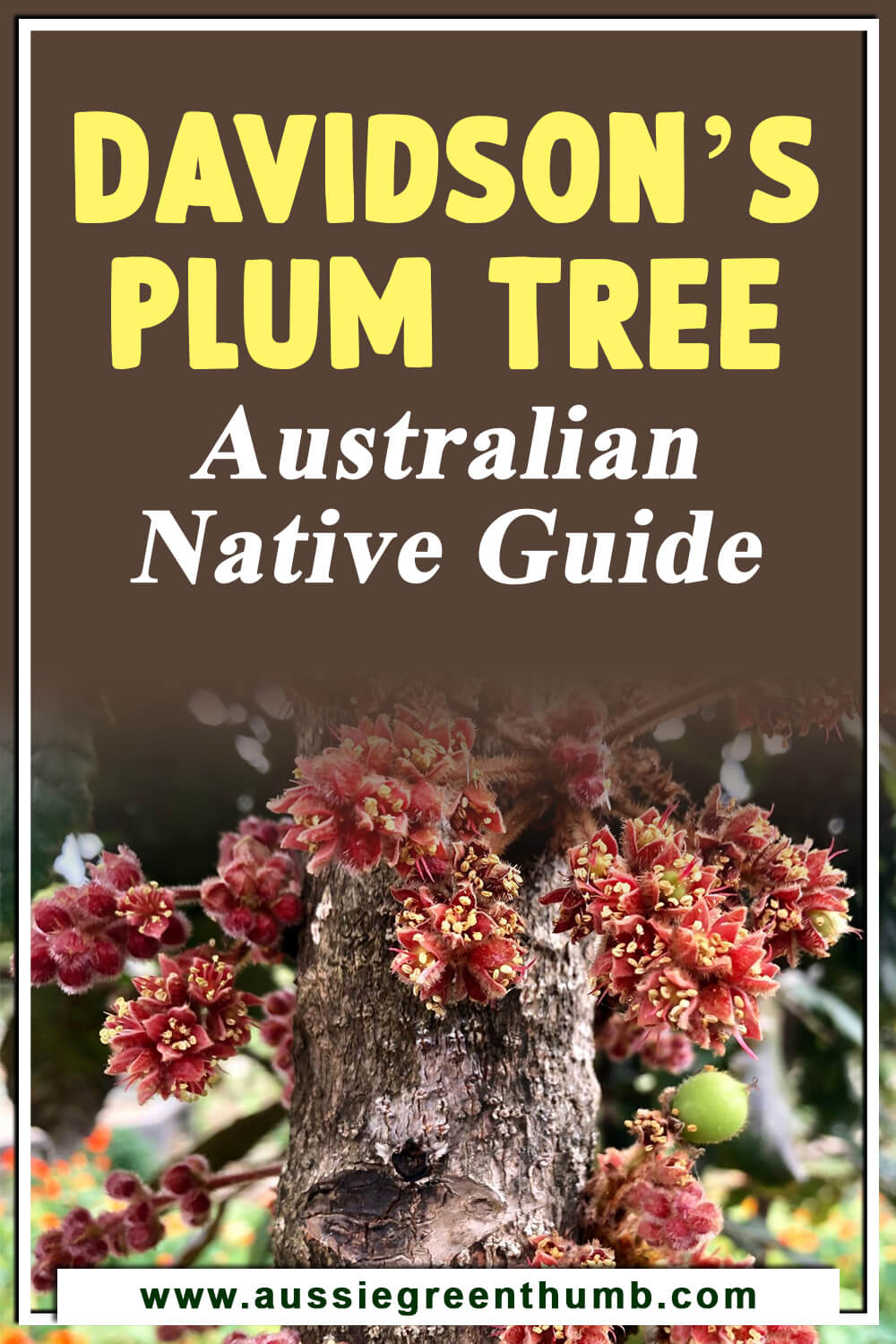
Boost Your Garden with Bounteous Davidson Plum
With so many attractive and practical qualities, the Davidson plum tree is a must-have addition for those looking for an easy to grow, low-maintenance native garden tree that produces bountiful fruits once established.
The luscious green frond-like foliage can seamlessly integrate itself into any garden collection, where it will add a wild and native touch to your landscape. These slender rainforest trees are perfect additions to Australian gardens and look fantastic year-round. Start growing your Davidson plum tree today!
Published on January 10, 2023 by Lorri Hopkins
Last Updated on February 22, 2024






Good afternoon, thanks for the informative article!
I just wanted to ask if the Davidson Plumb will ripped if picked green.
Thanks.
Nicole
Hi Nicole,
Thanks. And thanks for the challenging question! The answer is a little bit hit and miss I’m afraid.
In simple terms, yes, they will. And like most fruit you can put them in a paper bag with a ripe banana to speed up the process. And I’m guessing you’re thinking of doing this because you’ve got fruit flies getting to the ripe and semi-ripe fruit before you can harvest it?
The more complicated, and possibly truer answer, is that they can ripen, but they don’t taste nearly as sweet. Some fruit, like pears should be picked while they’re not ripe, and ripened off the tree. They taste better for it. But some, like tomatoes won’t ever have the same texture or flavour if picked while green.
Davidson’s Plum is more like tomatoes. It will change colour, but probably won’t turn fully dark, and the inside will be just as juicy but not as sweet because that final sweetness of ripe plums is caused by a combination of ethylene (which bananas provide) and the sugars from photosynthesis.
So you can provide ethylene, but plums off the tree won’t get their allotted sugars.
Sorry that was a bit long winded, but it’s a very specific fruit, and it’s picky about where it ripens. If it’s a choice of some plums or no plums thanks to fruit fly though, pick them as soon as they start to turn.
Best regards,
Lorri Hopkins